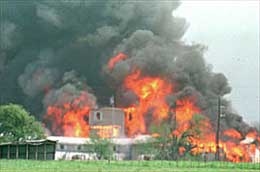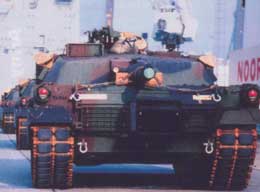|
October 16,
2003
Insight Magazine
By Kelly Patricia O'Meara
© 2003 News World Communications Inc.
Retired Army Gen. Wesley Clark wants to
be president and, given that he is a man who has worn
many hats during his controversial rise through the
ranks, many believe this qualifies him for the top
political job. But serious questions abound about his
actions as commander of the 1st Cavalry Division of the
Army's III Corps at Fort Hood, Texas, in 1993.
Clark has worn the hat of first-in-his-class graduate of
West Point, Rhodes scholar, decorated Vietnam combat
veteran, White House fellow, four-star general and even
Supreme Commander of NATO – a post from which he was
relieved.
There is one hat, though, that despite lingering
suspicions and accusations Clark neither has confirmed
nor denied wearing – a hat that many Americans might
find very disturbing for a military man seeking the top
civilian post in the U.S. government without first
registering with either political party or being so much
as elected dog catcher.
In his recently published book Winning Modern Wars,
Clark proclaims that the "American way was not to rely
on coercion and hard pressure but on persuasion and
shared vision," which has been taken by Democratic Party
doves to explain why the retired general has been an
outspoken critic of President George W. Bush's handling
of the war in Iraq. But while Clark may prefer a
"kinder, gentler" persuasion in dealing with U.S.
enemies abroad, critics are saying his actions at home
should be reviewed before deciding whether he is
qualified to be trusted with America's civil liberties.
 For
example, there is the 1993 siege of David Koresh's Mount
Carmel commune in Waco, Texas, where four
law-enforcement officers were killed and nearly 90
civilians – men, women and children – massacred by being
shot and/or burned alive. Those seeking an investigation
of his part in the Waco outrage say that Clark not only
played a hidden role in the military-style assault on
the Branch Davidians, but easily could have refused to
participate in what was a clear violation of the Posse
Comitatus Act that bars use of the U.S. military for
civilian law-enforcement activities. For
example, there is the 1993 siege of David Koresh's Mount
Carmel commune in Waco, Texas, where four
law-enforcement officers were killed and nearly 90
civilians – men, women and children – massacred by being
shot and/or burned alive. Those seeking an investigation
of his part in the Waco outrage say that Clark not only
played a hidden role in the military-style assault on
the Branch Davidians, but easily could have refused to
participate in what was a clear violation of the Posse
Comitatus Act that bars use of the U.S. military for
civilian law-enforcement activities.
Although Clark never publicly has discussed his role in
the attack on the Branch Davidians and did not respond
to Insight's requests for an interview to discuss his
role at Waco, there are indisputable facts that confirm
he had knowledge of the grim plans to bring the standoff
to an end.
Between August 1992 and April 1994, Clark was commander
of the 1st Cavalry Division of the Army's III Corps at
Fort Hood, Texas. According to a report by the U.S.
Department of the Treasury, the list of military
personnel and equipment used at Waco included: 15
active-duty military personnel, 13 Texas National Guard
personnel, nine Bradley fighting vehicles, five
combat-engineer vehicles, one tank-retrieval vehicle and
two M1A1 Abrams tanks. Additionally, Fort Hood
reportedly was used for much of the training for the
bloody attack on the Davidians and their children.
Based on the fact that military equipment from Fort Hood
was used in the siege and that training was provided
there, say critics, it is clear the commanding officer
of the 1st Cavalry had direct knowledge of the attack
and, more likely than not, was involved in the tactical
planning.
 West
Point graduate Joseph Mehrten Jr. tells Insight that,
"Clark had to have knowledge about the plan because
there is no way anyone could have gotten combat vehicles
off that base without his OK. The M1A1 Abrams armor is
classified 'Secret,' and maybe even 'Top Secret,' and if
it was deployed as muscle for something like Waco there
would have been National Firearms Act weapons issues.
Each of these M1A1 Abrams vehicles is armed with a
125-millimeter cannon, a 50-caliber machine gun and two
30-caliber machine guns, which are all very heavily
controlled items, requiring controls much like a chain
of legal custody. It is of critical importance that such
vehicles could not have been moved for use at Waco
without Clark's knowledge." West
Point graduate Joseph Mehrten Jr. tells Insight that,
"Clark had to have knowledge about the plan because
there is no way anyone could have gotten combat vehicles
off that base without his OK. The M1A1 Abrams armor is
classified 'Secret,' and maybe even 'Top Secret,' and if
it was deployed as muscle for something like Waco there
would have been National Firearms Act weapons issues.
Each of these M1A1 Abrams vehicles is armed with a
125-millimeter cannon, a 50-caliber machine gun and two
30-caliber machine guns, which are all very heavily
controlled items, requiring controls much like a chain
of legal custody. It is of critical importance that such
vehicles could not have been moved for use at Waco
without Clark's knowledge."
"This is something that the general staff would know in
the daily situation report or manning reports. Clark
would have known and, given his obsession for
micromanagement, there is probably someone who can place
him on the scene. He wouldn't have been able to resist
going in. At the very least there is no way he didn't
have knowledge," Mehrten continues.
So what if the general was aware that his military
equipment was being used against American civilians, and
so what if he even participated in the planning? Wasn't
he just following orders from above?
"To follow that order," explains Mehrten, "is to follow
a blatantly illegal order of a kind every West Point
officer knows is a violation of the Posse Comitatus Act.
Clark's obligation was to say, 'No, I'm not going to do
it.' Look, Clark went to the same institution I did and
at West Point we had extensive instruction in military
ethics and issues concerning how one avoids obeying an
illegal military order. It is drilled into our heads
from the earliest days as cadets that the
'I-was-just-following-orders' defense isn't necessarily
a good one."
He had the juice to say no, concludes Mehrten, "and he
could have and should have. But if he had done so he
probably wouldn't have gotten his next star. There is a
reason critics say this man was not recommended by the
military for that fourth star but got it anyway because
of political clout, just as there is a reason that Chief
of Staff Hugh Shelton brought him home early from Europe
because of 'character and integrity issues.' Sure the
Bradley vehicle could have been operated by a civilian,
but that's unlikely. This military equipment is very
specialized and would be virtually useless in the hands
of untrained operators. But just using military
equipment against civilians is running way afoul of
Posse Comitatus. Legally, if he were involved in it and
there were active-duty units where these armored
vehicles came from, then it is a clear violation of the
act. Clark's command at the time, 1st Cavalry, is an
active-duty federal division and it is my understanding
that these vehicles used at Waco were from Fort Hood –
his command."
Tom Fitton, president of the Washington-based Judicial
Watch, believes Clark has some questions to answer.
"The question for Clark," explains Finton, "is a fair
one in terms of corruption. Many Americans still are
troubled by what occurred at Waco, and we're very
interested in his role. Many people are going to ask
what are his views of the force [attorney general] Janet
Reno used at Waco and they'll want to know if he, were
he to become president of the United States, would
authorize that kind of force again. Specifically, was
Gen. Clark comfortable allowing forces and equipment
under his command to participate in a police raid or, at
best, a hostage situation? People are going to want to
know these things."
Michael McNulty, an investigative journalist and Oscar
nominee for his documentary, Waco: The Rules of
Engagement, tells Insight that, "From the standpoint of
what went on that operation had military fingerprints
all over it. The chain of command being what it is,
Clark had some responsibility, but to what degree we
really don't know."
McNulty takes a deep breath and then says, "My military
sources tell me that Clark and his second in command got
the communication from then-governor of Texas Ann
Richards, who wanted help with Waco. At that point Clark
or [Gen. Peter J.] Schoomaker should have asked
themselves, 'Religious community? Civilians, they want
our tanks?' and hung up the phone. Clark had to be
involved at the tactical level, he had to know what the
tactical plan was and he'd have to approve it. No one
has ever asked these questions of this man. Clark wasn't
even asked to testify before the congressional committee
investigating the circumstances of Waco. For me the real
question is one of character and, because of the
cover-up that's gone on with Waco, it could even be a
question of criminality. From the get-go, when the
assignment came down from III Corps, which is the
primary Army unit at Fort Hood and his division, Wesley
Clark had the opportunity to say 'Hey, wait a minute
folks, we're not gonna give tanks and personnel to the
FBI to use on civilians!'"
True, explains McNulty, "Clark didn't do this in a
vacuum. Whatever he did he at least is guilty of being a
good German – following orders. He was in a position to
put his foot down and say no. It was his men, his
equipment and his command. Everything that happened at
Waco, from the beginning, the U.S. military was involved
– including the strategic and tactical planning that
went on from Feb. 29 to April 19. Why weren't the guys
making the decisions debriefed and questioned by the
committee? I would hope that Clark would answer these
questions now, the sooner the better, because it appears
that Waco is about to follow him into the political
arena full force."
|